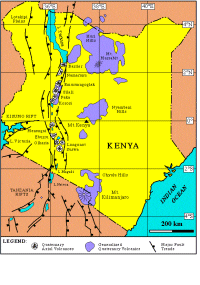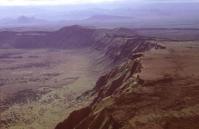Introduction
One of the most impressive geologic features of the Kenya rift valley is the occurrence of young, often large volcanic centers along its axis (Fig. 1). These are low-angle, multi-vent shield volcanoes composed principally of trachytic and basaltic lavas and pyroclastic deposits (McCall, 1968; Williams et al., 1984; MacDonald, 1987). The larger volcanoes, including Suswa, Paka, Silali, and Emuruangogolak, rise 700-1100 m above the rift valley floor (Randel and Johnson, 1991; Dunkley et al., 1993). Construction of the volcanoes began at less than 2 Ma, with most volcanism younger than ~1 Ma. Slightly before and simultaneous with the building of the large axial volcanoes, the inner rift valley experienced focused subsidence and intense faulting (Baker and Mitchell, 1976; Baker et al., 1978; Dunkley et al., 1993). Most of these faults are parallel to the rift margins, which vary in strike from NNW to NNE. The faults are spatially associated with eruptive fissures, lava domes and pyroclastic cones, reflecting complex interaction between upward movement of lava and structural weaknesses in older rocks. Starting in the Late Pleistocene, and particularly after about 100 ka, the inner rift entered a distinctly different phase of its volcanic history. The most dramatic occurrence of this latest period was the catastrophic collapse of many of the axial volcanoes, producing large, nearly vertically-walled calderas (Fig. 2). This was accompanied by the eruption of large volumes of ring-fracture lavas and pyroclastic material from smaller vents on the flanks of the volcanoes.
In general, the Kenya rift valley developed in response to east-west tensional stresses during the late Neogene (Strecker et al., 1990). The present-day minimum horizontal stress (Shmin), however, is now oriented NW-SE over most of Kenya (Bosworth et al., 1992). The period of rift valley caldera collapse occurred within a time of rapidly changing shallow crustal stress fields, perhaps indicating a genetic relationship (Bosworth et al., 1996). It is possible that stress fields could also have played a role in triggering the formation of collapse calderas in other continental rifts or in other tectonic regimes. One of the characteristics of several of the Kenya calderas is an elongation in plan view (McCall, 1968). We interpret caldera elongation as a reflection of an elliptical shape in the underlying magma chamber, and will show that the axis of elongation was parallel to the operative Shmin as determined from independent stress-field indicators. We therefore suggest that caldera ellipticity was stress-induced, and not controlled by the orientation of pre-existing faults. If this correlation is correct, then the shape of calderas from other geologic settings may be useful as indicators of paleo-stress field orientation.
We will begin with a brief review of the Quaternary volcanic and structural evolution of the Kenya rift valley axis, and then correlate this with temporal changes in the shallow crustal stress field. In conclusion we will propose a mechanical model for caldera elongation that is based on the well-known analysis of a cylindrical hole in an elastic material.

